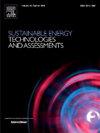Wave energy systems in the Vietnamese context: Proposal for onshore and offshore integration based on a techno-economic analysis
IF 7.1
2区 工程技术
Q1 ENERGY & FUELS
Sustainable Energy Technologies and Assessments
Pub Date : 2025-04-11
DOI:10.1016/j.seta.2025.104268
引用次数: 0
Abstract
Renewable energy introduction is one of the main goals for the evolution of the power system in the 21st century. The most popular technologies are based on photovoltaic panels or wind turbines, but other energy sources such as sea waves energy should be also exploited. Moreover, although a great effort has already been spent in developed countries, pushing the investments through economic subsidies, many developing countries are lagging, still basing most of their power generation-mix on fossil fuels. In this study, two prototypes for sea wave energy exploitation are illustrated, one for onshore and one for offshore application. To demonstrate their feasibility, a techno-economic analysis for their introduction in Vietnam is provided, comparing their performance with more mature technologies such as wind and solar. Results show that, with adequate economic conditions, this technology might be a good support to the decarbonization of the energy system. Regarding the renewables policy, Vietnamese government should support these renewable energies with a higher feed-in tariff to make the investments profitable. Nevertheless, with reference to the offshore technology, a renewable mix based on this energy converter was proved to be economically viable, with LCOE between 6.45 and 6.56 cUSD/kWh and NPV between 4,500 and 51,700 kUSD over 20 years.
越南背景下的波浪能系统:基于技术经济分析的陆上和海上一体化建议
引进可再生能源是21世纪电力系统发展的主要目标之一。最受欢迎的技术是基于光伏板或风力涡轮机,但也应该开发其他能源,如海浪能。此外,尽管发达国家已经付出了巨大的努力,通过经济补贴推动投资,但许多发展中国家仍然落后,它们的大部分发电结构仍然以化石燃料为基础。在这项研究中,说明了两种海浪能开发的原型,一种用于陆上,一种用于海上。为了证明它们的可行性,提供了在越南引进它们的技术经济分析,将它们的性能与更成熟的技术(如风能和太阳能)进行比较。结果表明,在适当的经济条件下,该技术可以为能源系统的脱碳提供良好的支持。关于可再生能源政策,越南政府应该通过更高的上网电价来支持这些可再生能源,以使投资有利可图。然而,参考海上技术,基于该能源转换器的可再生能源组合被证明是经济可行的,20年的LCOE在6.45至6.56 cUSD/kWh之间,NPV在4,500至51,700 kUSD之间。
本文章由计算机程序翻译,如有差异,请以英文原文为准。
求助全文
约1分钟内获得全文
求助全文
来源期刊

Sustainable Energy Technologies and Assessments
Energy-Renewable Energy, Sustainability and the Environment
CiteScore
12.70
自引率
12.50%
发文量
1091
期刊介绍:
Encouraging a transition to a sustainable energy future is imperative for our world. Technologies that enable this shift in various sectors like transportation, heating, and power systems are of utmost importance. Sustainable Energy Technologies and Assessments welcomes papers focusing on a range of aspects and levels of technological advancements in energy generation and utilization. The aim is to reduce the negative environmental impact associated with energy production and consumption, spanning from laboratory experiments to real-world applications in the commercial sector.
 求助内容:
求助内容: 应助结果提醒方式:
应助结果提醒方式:


